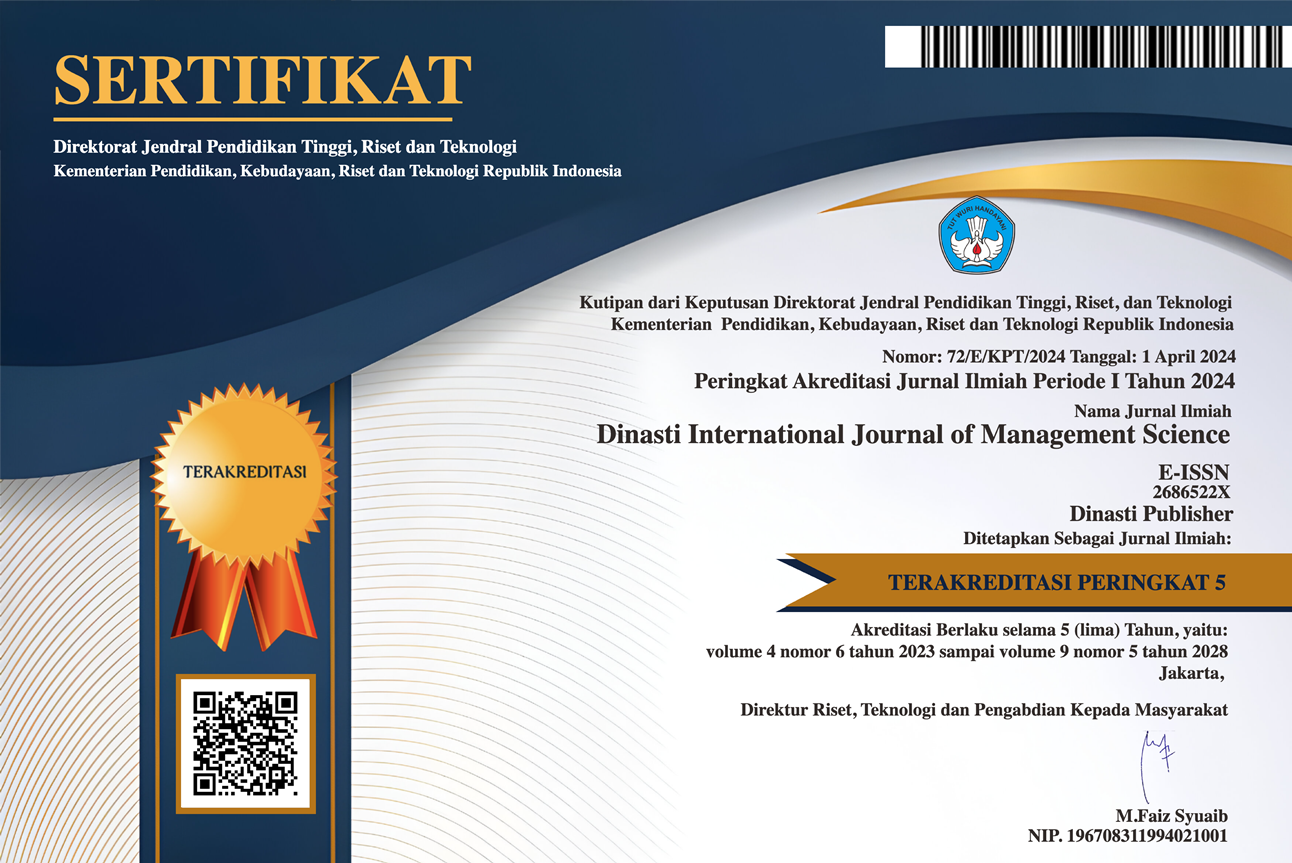Analysis of the Influence of Leadership Style and Work Motivation on Employee Performance (Literature Review)
DOI:
https://doi.org/10.38035/dijms.v6i4.4338Keywords:
Leadership, Employee Performance, Work MotivationAbstract
The success rate of employee performance can be determined by the leadership within a company, specifically by examining the leadership style implemented. Leadership style is an approach or method chosen to direct and influence subordinates so that the company's productivity level, effectiveness, profitability, performance, and employee motivation can be achieved in accordance with the desired goals. An effective leadership style in managing company resources will naturally influence employee behavior, as indicated by the creation of work motivation, which in turn will ultimately affect the company's overall performance. The literature review provides a framework related to new findings and previous findings in identifying indications of progress or lack thereof in the results of a particular study. The method used in the literature review follows a systematic approach to analyzing data through a simplified approach. The stages involved in the simplified approach analysis include summarizing each piece of literature, conducting a critical appraisal simultaneously to determine the strengths and weaknesses of the literature, and examining the relationship between one piece of literature and another. The author considers all research designs used in identifying the influence of leadership style and work motivation on employee performance.
References
Adriyanti, Y., et al. (2023). Pengaruh Gaya Kepemimpinan dan Motivasi terhadap Kinerja Karyawan: Studi Kasus pada Perusahaan XYZ. Jurnal Manajemen dan Bisnis, 7(3), 221-239.
Bakker, A. B., & Demerouti, E. (2007). The Job Demands-Resources Model: State of the Art. Journal of Managerial Psychology, 22(3), 309-328.
Bangun, W. (2014). Manajemen Sumber Daya Manusia: Teori dan Praktek. Jakarta: Erlangga.
Fahmi, F. (2016). Strategi Kepemimpinan yang Efektif untuk Meningkatkan Kinerja Karyawan. Jurnal Ekonomi dan Bisnis, 3(4), 405-417.
Gagne, M., & Deci, E. L. (2005). Self-Determination Theory and Work Motivation. Journal of Organizational Behavior, 26(4), 331-362.
Goleman, D. (2000). Emotional Intelligence: Why It Can Matter More Than IQ. Bantam Books.
Hersey, P., & Blanchard, K. H. (1982). Management of Organizational Behavior: Utilizing Human Resources. Prentice Hall.
Herzberg, F. (1959). The Motivation to Work. John Wiley & Sons.
Kartono, K. (2016). Aspek-Aspek Kepemimpinan dalam Organisasi. Yogyakarta: Pustaka Pelajar.
Kuvaas, B. (2006). Work Motivation and Performance: A Theoretical Framework. Journal of Applied Psychology, 91(1), 25-39.
Luthans, F. (2005). Organizational Behavior. McGraw-Hill.
Malayu, S. P. (2015). Motivasi Kerja dan Pencapaian Kinerja Karyawan. Bandung: Alfabeta.
Mangkunegara, A. A. (2011). Manajemen Sumber Daya Manusia. Bandung: Remaja Rosdakarya.
McGregor, D. (1960). The Human Side of Enterprise. McGraw-Hill.
Riani, N., & Putra, I. (2017). Gaya Kepemimpinan dan Kinerja Karyawan: Sebuah Pendekatan Empiris. Jurnal Manajemen Sumber Daya Manusia, 4(2), 102-116.
Rivai, V. (2014). Kepemimpinan dan Perilaku Organisasi. Jakarta: PT. Raja Grafindo Persada.
Robbins, S. P. (2001). Essentials of Organizational Behavior. Prentice-Hall.
Robbins, S. P. (2006). Organizational Behavior: Concepts, Controversies, Applications. Prentice-Hall.
Runtu, M. (2011). Gaya Kepemimpinan dalam Organisasi. Jurnal Manajemen Sumber Daya Manusia, 2(3), 221-234.
Setiyawan, I., & Waridin, S. (2006). Pengaruh Gaya Kepemimpinan dan Motivasi Kerja terhadap Kinerja Karyawan. Jurnal Manajemen, 1(2), 123-145
Sigit, W. (2021). Pengaruh Gaya Kepemimpinan Terhadap Motivasi Kerja Karyawan. Jurnal Manajemen Bisnis, 8(1), 75-87.
Thoha, M. (2013). Teori dan Praktik Kepemimpinan dalam Organisasi. Jakarta: Rajawali Press.
Tualai, A., & Aima, A. (2022). The Impact of Leadership Styles on Employee Performance in the Public Sector. Public Administration Review, 82(5), 753-768.
Uno, H. B. (2012). Teori Motivasi dan Pengukurannya. Jakarta: Bumi Aksara.
Veizhal, L. (2020). Analisis Kinerja Karyawan dalam Perspektif Manajemen. Jurnal Manajemen, 4(2), 125-140.
Winardi, J. (2016). Manajemen Sumber Daya Manusia dan Perilaku Organisasi. Jakarta: Ghalia Indonesia.
Yulk, G. (2010). Leadership in Organizations. Pearson Education.
Downloads
Published
How to Cite
Issue
Section
License
Copyright (c) 2025 Radja Martin Sirait, Samto Hadi Isnanto

This work is licensed under a Creative Commons Attribution 4.0 International License.
Authors who publish their manuscripts in this journal agree to the following conditions:
- The copyright on each article belongs to the author(s).
- The author acknowledges that the Dinasti International Journal of Management Science (DIJMS) has the right to be the first to publish with a Creative Commons Attribution 4.0 International license (Attribution 4.0 International (CC BY 4.0).
- Authors can submit articles separately, arrange for the non-exclusive distribution of manuscripts that have been published in this journal into other versions (e.g., sent to the author's institutional repository, publication into books, etc.), by acknowledging that the manuscript has been published for the first time in the Dinasti International Journal of Management Science (DIJMS).
















































